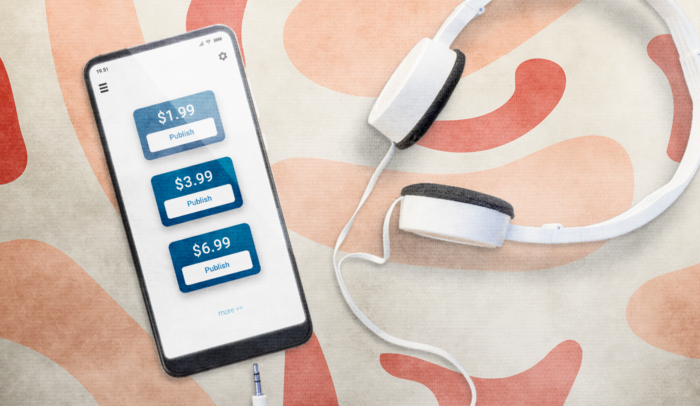How much should I charge?
It’s one of the biggest questions Authors have once it’s time to publish their audiobook.
Generally, an audiobook’s price depends on how long the book is. Here’s the TL;DR version: a 5-hour book is usually priced between $10 and $20.
But for Authors who want a deeper dive into the topic of pricing, there are several ways to find the sweet spot for your audiobook.
This article will cover the theory behind choosing the perfect price for your audiobook. I will also explain how to set your price on different distributor platforms.
How Much Should I Charge for My Audiobook?
The largest audiobook market, by far, is Amazon/Audible. They control 41 percent of the U.S. audiobook market.
Amazon has a straightforward set of rules for audiobook pricing:
- Audiobooks under 1 hour: under $7
- 1 – 3 hours: $7 – $10
- 3 – 5 hours: $10 – $20
- 5 – 10 hours: $15 – $25
- 10 – 20 hours: $20 – $30
- Over 20 hours: $25 – 35
These are their standard guidelines, but Authors should be aware that Amazon reserves the right to set the price of any audiobook on their platforms. Even if your book is 15 hours long, it’s Audible’s prerogative if they decide to sell it for $5.
Because Amazon dominates the audiobook market, its pricing standards have influenced prices across the board. Even if you aren’t listing your book on Amazon, their guidelines may give you a good starting place.
But length isn’t the only factor that goes into finding the ideal price for your book. Here are some other important factors to keep in mind:
- What genre is your book, and what are similar audiobooks selling for? If you’ve written a business development book, it doesn’t make sense to compare its price with what a mystery novel costs. Consider how much your target readers are willing to pay for a book in your field. Check out the prices offered by some of your competitors or Authors you admire.
- How much did your book cost to produce? You may want to work backward from your total production costs to determine your book’s price. For example, if you spent $2,500 to create your audiobook and think you can reasonably sell 250 copies, you could set your audiobook price at $10 and cover your expenses. Of course, that’s assuming you’re earning 100 percent royalties, which you likely won’t. Your royalty rate is determined by which platforms you use to distribute your book. To learn more about audiobook royalties and distribution, see this post.
- How many copies do you expect to sell? A best-selling Author may be able to set a lower price because the sheer quantity of sales will boost their earnings. But for independent Authors, a “how-low-can-you-go” promotional price can be risky. Yes, you may entice some people into buying your book because it’s cheap, but you may not recoup your costs unless you can sell it in bulk.
- What is the price of your eBook or print book? An audiobook typically costs two or three times more than the eBook version (more on why below). If your book is already published in other formats, is it selling well at the list price? If so, that price may give you a good benchmark. If not, you might consider adjusting the price of all your formats.
- What are your goals for the book? Some Authors want to maximize their potential revenue per sale. In that case, they might opt for a higher price. Other Authors care more about exposure, so they might decide to go with a lower price in the hope of attracting new readers. Knowing what you want to achieve with your book will help you find a price suitable to your needs.
Setting the perfect list price for an audiobook can be tricky. If you go too high, listeners won’t want to take a chance on your book. But if you price it too low, you’ll be leaving money on the table.
As a rule of thumb, there are four basic price categories for audiobooks:
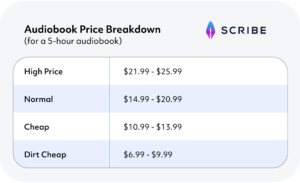
While there are no hard-and-fast rules for audiobook pricing, there are a few strategies we recommend.
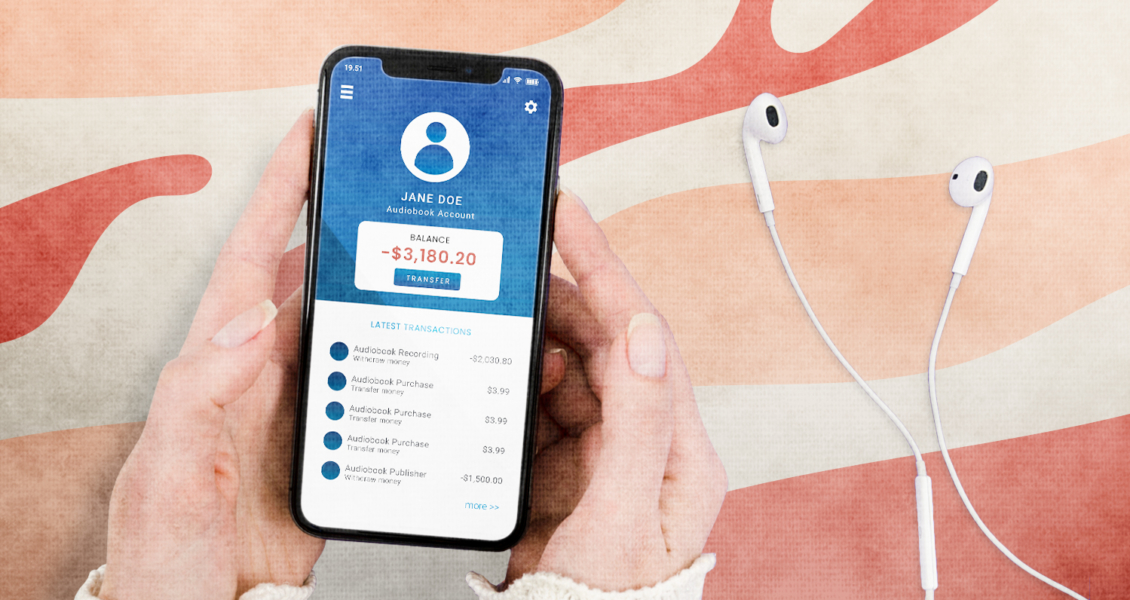
First, avoid setting a dirt-cheap price for your book. You will probably lose money on your audiobook that way. You’ll also undermine your book’s credibility.
Consumer research shows that books with “bargain” prices often sell fewer copies than reasonably priced books. That’s because books are Veblen goods, meaning people will see the price of your book as a reflection of its value. If you price your audiobook too low, people will see it as having less worth.
But be cautious. If you price your book too high, you will also miss out on sales. Ideally, we recommend choosing a normal price for your book because it’s the best way to strike a balance between consumer perception and sales.
Secondly, be as consistent as possible across platforms. As I’ll explain below, it’s possible to set a different price for your book on different platforms, so you could theoretically list your book for $5 on Kobo and $25 on Google Play.
I don’t recommend doing this. Consumers expect and appreciate consistency. And when it comes to audiobooks, most have a preferred platform. Listeners who automatically gravitate toward Google might purchase your book for $25. When they discover a few days later that the book is cheaper on Kobo, they will likely be confused, frustrated, or angry.
Amazon doesn’t allow you to set your own price, so you can’t always guarantee that your book will have the exact same price across platforms. That’s why I recommend picking a price that falls in Amazon’s range. That way, the book’s Amazon price won’t differ too greatly from the price you set on other outlets.
When your price is the same across all retail channels, you send a consistent, coherent, and reliable message to your audience.
Still, there may be times when it makes sense to alter your book’s price on a specific platform. For example, Kobo readers are a dedicated group, and you might decide to run an exclusive, two-week sale only for Kobo fans.
If you do offer different prices on different platforms, do it with intention. Use your pricing as a promotional opportunity and be clear about why you’re doing it. Don’t let readers see you as fickle.
Audiobook Pricing vs. Print and eBook Pricing
As I mentioned, your audiobook price will likely be significantly higher than that of your eBook.
Here’s a breakdown of the average price range of each format:
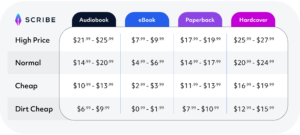
Many readers wonder, Why are audiobooks so much more expensive than eBooks?
There’s an easy answer: audiobooks are more expensive to produce.
Making an eBook requires time, but it’s not very resource-intensive.
Audiobooks, on the other hand, require specialized equipment and labor. Achieving flawless narration and audio quality takes a lot of skill, preparation, and behind-the-scenes work that listeners aren’t always aware of. And all that work costs money.
To make an audiobook, Authors should plan to spend between $2,500 and $3,750 for a 5-hour book. That’s $500 to $750 per finished hour of audiobook content.
Audiobooks must be more expensive if Authors want to break even or make a profit.
How to Set the Price for an Audiobook in Distributor Platforms
Below is a quick guide for setting your audiobook’s price on 4 major distribution platforms.
Depending on which platforms you’re using to distribute your book, you may only need to set your price in one place. For more information on how to select audiobook distributors, see this post.
ACX (Audible)
ACX, or Audiobook Creation Exchange, is Amazon’s audiobook distribution platform. Books distributed through ACX are available on Amazon, Audible, and iTunes.
Amazon does not allow Authors to set the price for their audiobooks. If you distribute through ACX, each retailer will price your product for you.
Author’s Republic
Once you’ve signed up with Author’s Republic, you will have access to an Author’s dashboard.
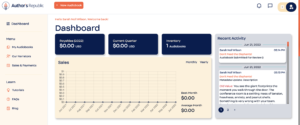
On the upper left-hand side of the screen, you will find the option for “New Audiobook.” Once clicked, Author’s Republic will guide you, step by step, through the process of publishing your audiobook.
You will choose between “Produce an Audiobook” or “Distribute an Audiobook.” At Scribe, we choose the latter because Author’s Republic is our go-to distributor.
Once you’ve made your choice, you will be able to fill out your book’s basic information and description in a tab called “Get Started.” You must complete this tab to get to the second tab, which is called “Metadata.”
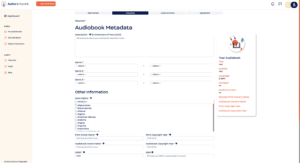
Scroll down to the field labeled “MSRP” (Manufacturer’s Suggested Retail Price). This is where you will list your book’s ideal price.
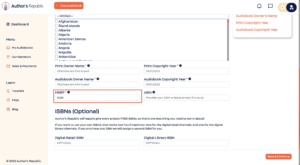
You are able to set any price you want in this field, but Author’s Republic offers a caveat—an important one that applies to all audiobook distributors: “Some retailers may not use this MSRP when pricing your audiobook.”
For example, if you want your book to be listed for $20, Author’s Republic might be able to get it listed at that price on Google Play, Kobo, or other apps. But Amazon and iTunes may reject that list price and assign your book a different price based on their guidelines.
Audiobook distribution platforms like Author’s Republic give Authors more power when it comes to setting prices, but that power isn’t absolute. Authors are still subject to the terms of individual retailers.
Findaway Voices
Findaway Voices offers an interactive tool to help Authors determine the best price for their audiobook.
Once you sign up with Findaway Voices and upload your book’s audio files, you will be able to access your book’s information page.
Scroll down to the “Set Price” section and click “Calculate your recommended list price.”
The tool will walk you through some pricing considerations and suggest some minimum, maximum, and median list prices. You can either save those recommended prices to your project or choose to create your own.
Note that you will be prompted to select two different prices: retail list price and library list price. The retail list price is the price that individual consumers will pay for your book. Libraries typically pay a higher price for books because a single copy circulates among many readers. Typically, the library price will be 2-3 times as much as the retail price.
If you don’t want to use Findaway Voices’ calculation tool, you can also directly enter your desired list price from the “Set Price” section of your book’s information page.
Kobo
Kobo is part of Rakuten, a Japanese-based e-commerce company, so their platform Kobo Writing Life (KWL) has a strong international presence. Authors have a lot of pricing flexibility on Kobo and can set their prices in 16 different currencies.
To set the price on a new audiobook, log into your account and click “Create New Audiobook.” You will be guided through several steps—describing your audiobook, uploading your audio files, and creating a table of contents—before reaching the pricing option.
You will set the price of your book starting with your default currency (probably USD). Then, Kobo automatically converts it to the other available currencies using recent exchange rates.
Authors have the ability to overwrite any of the converted prices and may strategically charge more or less in certain markets. This may be one of the only instances in which we’d recommend offering your book at slightly different prices.
Here’s why, as explained on the Kobo blog:
“Setting custom prices for every geo creates a more pleasant shopping experience for potential readers; $2.99 is a much more attractive price than the automatically converted price of $2.61, and customers are just as likely to spend $2.99 as they are to spend $2.61. Why miss out on that extra profit when you don’t have to?”
When you click into a field to set a custom price, you will see a small pop-up if Kobo suggests that you change your price to make it more attractive to buyers in a specific region.
You can edit your price settings at any time by clicking into the information page for your published audiobook. Click on “View/Edit Prices” to make any changes you wish.
Kobo also allows Authors to schedule future sales or price changes. In the “View/Edit Prices” screen, you can click “Schedule a sale” or “Schedule a future price change.” For more details on setting prices and scheduling, see this page on the Kobo website.
Final Thoughts
Finding the right price for your audiobook can be a delicate dance.
It may be tempting to take Amazon’s tactic and reduce the book’s price to a simple function of its length. But most Authors will also sell their books on non-Amazon platforms. So, they must take reader psychology into consideration.
What’s the perfect price that will convince a reader to buy your book while still thinking of your book as a valuable resource?
What’s the price that will help you—the Author—maximize your earnings and exposure?
How many copies, at what price, do you need to sell to recoup your production costs? And how do royalty percentages across different platforms complicate those calculations?
It’s not always easy to find the answer. That’s why Scribe makes it part of our mission to help Authors find that sweet spot with their audiobook price. We’ve worked with thousands of Authors, so we know how to align a book’s list price with its Author’s objectives.
If you find yourself confused by the intricacies of audiobook pricing, Scribe Audiobook is here to help.


